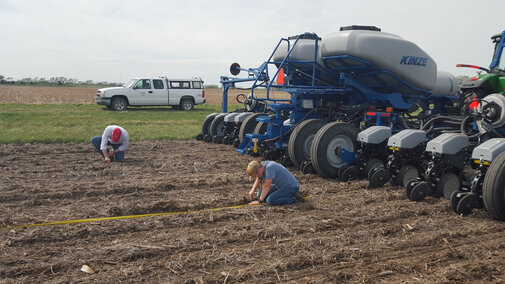Announcements of emerging agricultural technologies occur more frequently with each growing season. For most producers, the biggest question about these advanced systems is “How will an investment or upgrade pay off in my operation.”
Members of the multi-disciplinary UNL Precision Ag Research and Extension team are working with local and regional industry groups and, most importantly, cooperating producers to examine how one new technology—the multi-hybrid planter—might benefit producers in the future.
Multi-hybrid planters generally can plant two seed varieties housed in separate bulk tanks on the planter. However, the potential for these systems extends well beyond simply planting two seed varieties; their ability to also manage different seed treatments is often overlooked. These systems can be thought of as “multi-product” or “multi-treatment” planters.
Work on this project began in mid-2015 after a meeting at Oklahoma State University among university and industry specialists who were trying to determine future research needs for planting technologies. The group had a great discussion with industry professionals who were committed to creating collaborative projects to get better information out to potential technology adopters.
With support from Nebraska Extension, Rachel Stevens, a graduate student in mechanized systems management, was hired to design and carry out field studies that would address placement of hybrid seed with varying traits to deal with moisture stress as well as soybean seed treatment for Sudden Death Syndrome.
This project is allowing researchers to get to the heart of producers’ questions about this technology:
- How do we determine zones?
- What spatial data layers do we need and across how many years?
- How do we evaluate the success of management decisions and continue to refine and improve these zones and decisions?
The UNL team is eager to see how these results might positively influence producers’ management decisions.
The project is being conducted in cooperation with local producers and has received broad support from industry including Kinze Manufacturing, DuPont Pioneer, and Bayer Crop Science. Within UNL, researchers Richard Ferguson (Agronomy), Loren Giesler (Plant Pathology), and Santosh Pitla (Biological Systems Engineering) and extension educators Keith Glewen, Nathan Mueller, and Laura Thompson are collaborating on the project.

Despite the rains, five corn and two soybean fields have been planted so far this year with one more soybean field to go. Sites include dryland and irrigated cropping systems. While more than one year of data is needed to study this technology, the project team believes that preliminary data from this initial year will help build capacity for future studies.
Results from the field sites will be distributed through Nebraska Extension.

